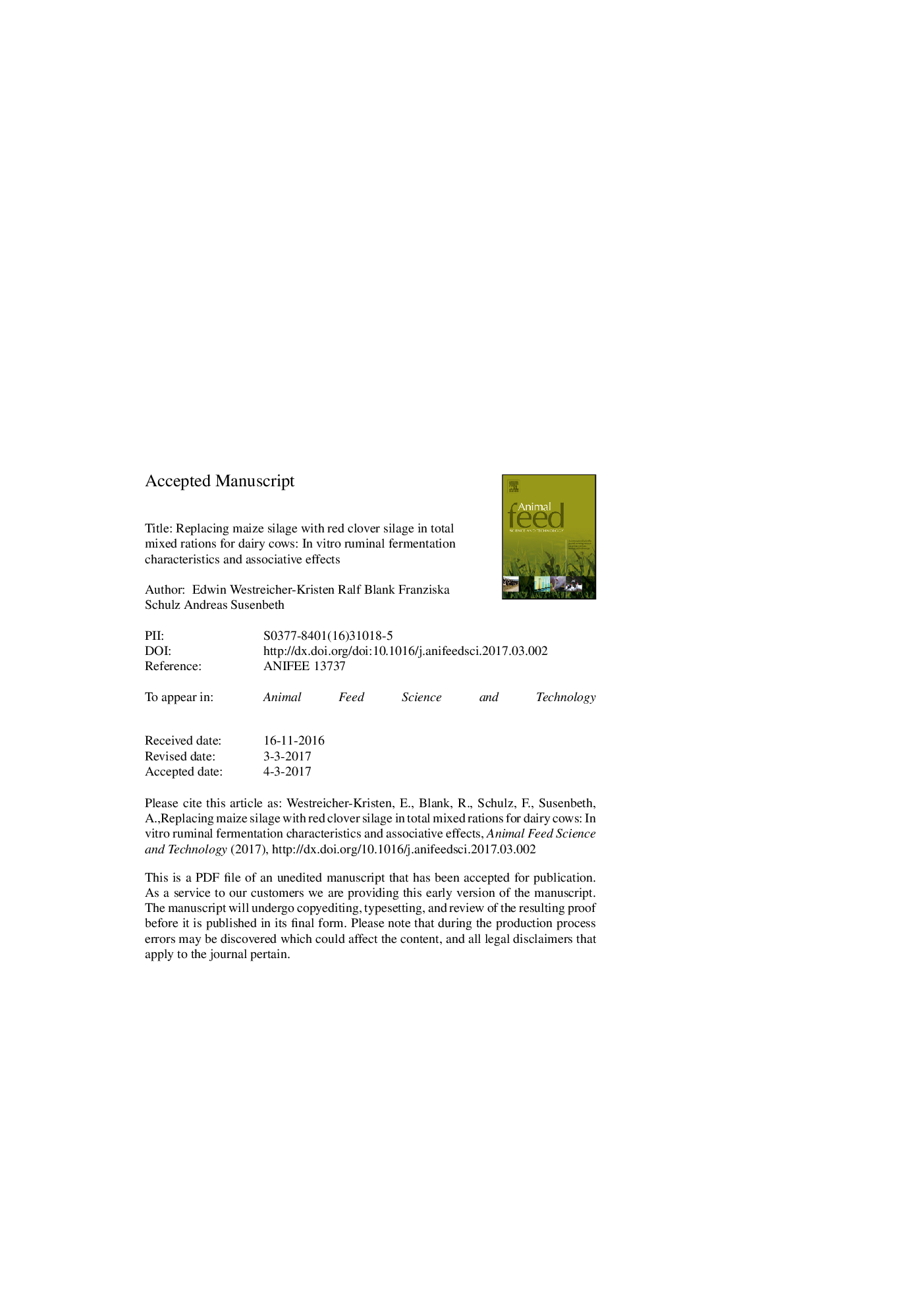| Article ID | Journal | Published Year | Pages | File Type |
|---|---|---|---|---|
| 5538739 | Animal Feed Science and Technology | 2017 | 35 Pages |
Abstract
The objective of this study was to evaluate fermentation characteristics and associative effects by replacing maize silage (MS) with red clover silage (RCS) using in vitro techniques. Treatments included total mixed rations (TMR) containing forage (MS and RCS) and concentrates (0.75:0.25) with targeted proportions of RCS in TMR of 0.15 (RCS15), 0.30 (RCS30), 0.45 (RCS45), and 0.60 (RCS60) on a dry matter (DM) basis. The Hohenheim gas test (HGT) was used to describe the kinetic of gas production. The modified HGT was used to estimate the utilizable crude protein at the duodenum (uCP). Effective uCP was calculated according to passage rates of 2, 5 and 8%/h (uCP2, uCP5 and uCP8, respectively). Associative effects were defined as the differences (%) between the observed values of TMR and the sum of the observed values of the individual components of the TMR. The gas production from incubation time 8 to 72Â h, the potential gas production (A), organic matter digestibility (OMD), and metabolizable energy (ME) decreased with increasing levels of RCS. The effective uCP2 content was similar between TMR (average 93.7Â g/kg DM). However, uCP5 and uCP8 were reduced with increasing level of RCS (from 145 to 136Â g/kg DM, and from 172 to 157Â g/kg DM). Positive associative effect was found for cumulative gas production. But this effect was reduced when increasing incubation time and when increasing levels of RCS. Associative effects of gas production at 24Â h of incubation averaged 1.35%. Consequently, those of ME (â0.09 to 1.01%) and OMD (1.60 to 2.76%) were of minor relevance as well. Associative effects on uCP depended on rate of passage and on level of RCS. Within TMR, associative effects on uCP increased with increasing rate of passage (e.g. for RCS15; 3.67 and 5.39% for 2 and 8%/h, respectively). Within rate of passage, associative effect was reduced with increasing level of RCS (e.g. for uCP8; 5.39 and â0.95% for RCS15 and RCS60, respectively). Based on associative effects of fermentation characteristics and estimated uCP content, this study suggests that incrementing levels of RCS may lead to a reduction on the feed value of diets, and that the optimal proportion of RCS:MS in TMR to achieve beneficial effects was 0.15:0.60 on DM basis. Therefore, caution should be taken before introducing high levels of RCS in rations of high-yielding dairy cows. However, these results should not be directly extrapolated to in vivo conditions.
Keywords
SBMmicrobial CPcrude ashOMDHohenheim gas testaNDFomUCPNH3-NNPNADFomUDPHGTRCSMCPG24TMRAmmonia-nitrogenProtein valuenet energy for lactationMetabolizable energyGas productionNELIn vitroMaize silageRed clover silageRumenether extractorganic matterdry matterNitrogenNon-protein nitrogenOrganic matter digestibilitycrude proteintotal mixed rationSoybean meal
Related Topics
Life Sciences
Agricultural and Biological Sciences
Animal Science and Zoology
Authors
Edwin Westreicher-Kristen, Ralf Blank, Franziska Schulz, Andreas Susenbeth,
